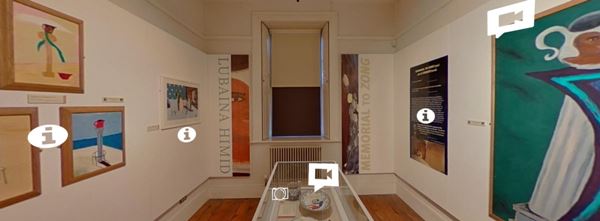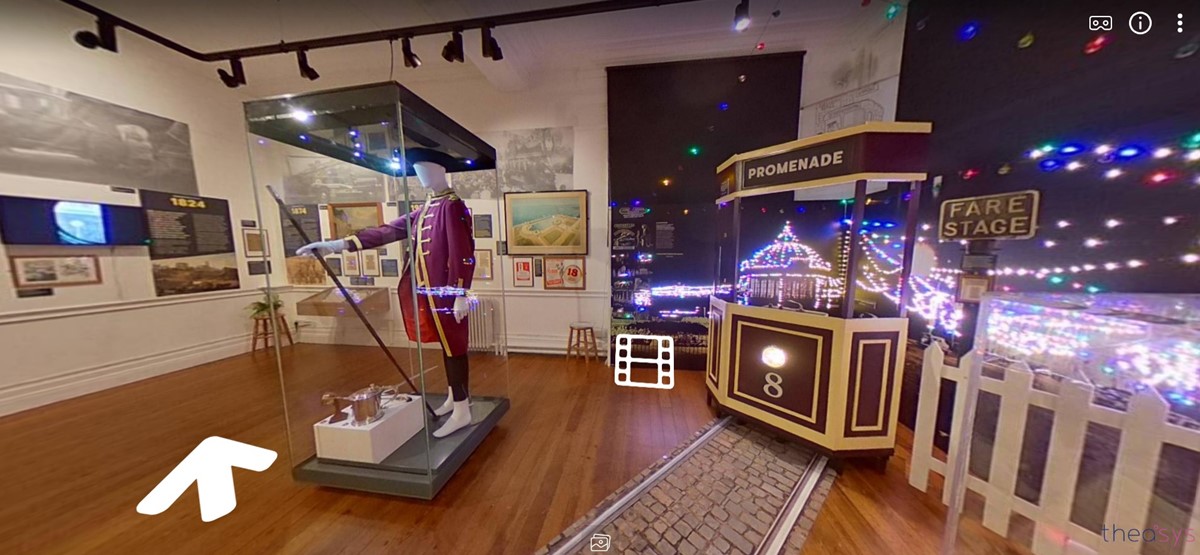Virtual Exhibitions
Since 2021 we've been creating 360° virtual tours of many of our temporary exhibitions. We'll keep adding to these over time, so check back here for updates.
Click on the titles in the list below to view the virtual exhibitions.

Memorial to Zong - This intimate and emotional exhibition by Turner Prize winning artist Lubaina Himid was exhibited at the Lancaster Maritime Museum in 2021. The Zong was an overloaded slave ship which crossed the Atlantic in 1781. Due to a navigational error, the ship missed its destination in the Caribbean and had to spend an extra three weeks at sea. Drinking water was (according to the Captain) growing short and sickness had spread among the enslaved Africans and crew. Approximately 131 enslaved people were thrown mercilessly overboard and drowned, so that the merchants could claim insurance money on the slaves as ‘lost cargo’. The crew were tried in 1783, although the case was heard as an insurance dispute rather than a murder trial. The case came to symbolise the horrors of the Middle Passage and strengthened the voice and force behind the campaign to abolish slavery. Professor Lubaina Himid’s exhibition is a powerful re-interpretation of the history and brutality of the slave trade and remembers the Zong Massacre. This is our flagship virtual tour, an immersive online experience which goes far beyond pictures and information about the artwork on display. Explore the stories behind the exhibition in more depth with expert commentary, videos, music, images and behind-the-scenes insights.
Additional resources:
- Download information and links relating to Zong and the Transatlantic slave trade (PDF, 1MB)
- Download Biographies of individuals involved in the Zong story (PDF, 229KB)
- To find out more about the work of Lubaina Himid, visit her website.
Navigation: Time, Tides, Stars & Charts - Imagine being in the middle of the Pacific Ocean (a mind-boggling 63 million square miles), and in every direction there is water. How do you decide which way to sail? This exhibition looks at the history of navigation at sea, from prehistory to the present day. Objects from the Maritime Museum's collection tell some unique local stories as well as illustrating the broader developments in technology across the ages and around the world.
Lancastrians of Science - A remarkable feature of 19th century Lancaster was its ability to nurture a number of young men who later made their mark on scientific culture. The economic landscape of Lancaster was changing rapidly, with new opportunites for students and apprentices in fields such as medicine and chemistry. This exhibition looks at the achievements of individual Lancastrians as well as how they fitted into the wider context of the Scientific World.
Learning from the Past (So that we are not condemned to repeat it) - This exhibition presents stories of people from across Europe who worked for peace, promoted international co-operation and resisted political extremism in the interwar years. It combines research and artwork from a 4-year Erasmus funded project by Global Link in Lancaster, together with seven European partner organisations.
Reginald Aspinwall: A Troubled Landscape - Reginald Aspinwall was a talented but troubled artist. He made Lancaster his home, painting local beauty spots in oils and watercolours. His paintings were popular locally and gained critical acclaim further afield, but his success was hampered by his erratic lifestyle and struggles with alcoholism. Displayed at the City Museum in 2021, one hundred years after Reginald Aspinwall's death, this exhibition brings together artworks from our own collection and from the Harris Museum, Art Gallery & Library in Preston.
Going to East Road: a history of Lancaster Workhouse - This exhibition explores the role of a workhouse, its inhabitants, and how it fitted into the wider Lancaster community. Original documents, photos and oral histories tell the stories of the people who lived and worked inside. These stories are shocking, sad, and sometimes hopeful, but often imcomplete. We have tried to give a voice to those once forgotten, now remembered.

The Hinge of Fate: living with uncertainty in 1942 - Winston Churchill described 1942 as 'The Hinge of Fate' - a turning point at which the second world war could have been lost or won. In Lancaster, people adapted to rationing, new laws and new roles supporting the war effort. Overseas, soldiers of the King's Own Royal Regiment were active in Europe, Africa, the Middle East and Asia. Their bravery helped to change the outcome of the war. This exhibition explores how ordinary people responded to the uncertainty of 1942, overcoming loss, danger, worry and hardship.
- Discover more from the Hinge of Fate project, including videos and a walking trail around Lancaster: Hinge of Fate project page.
Slavery Family Trees - Created by the Lancaster Black History Group, this exhibition is the culmination of a groundbreaking research project which uncovered the stories of some of Lancaster's most prolific merchant families involved in transatlantic slavery. Around 30,000 enslaved people were traded across the Atlantic in the 18th century by Lancaster-based merchants. The profits from this trade and from the goods produced by these workers formed the foundation of several merchant dynasties, and funded a good part of Lancaster's growth from a small market town into the city we know today.
100 Years, 100 Objects - Our centenary exhibition was displayed in the City Museum in 2023, exactly 100 years after its founding in 1923. The 100 objects featured represent the breadth and depth of the collection that we've accumulated in that time, revealing a wealth of local stories from prehistory to the present day.
Standfast & Barracks: A Century of Design - This unique exhibition celebrates the 2024 centenary of the world-renowned Lancaster-based textile company, Standfast and Barracks. It explores the history of the company and its designs, created by generations of local talent.
Corporation Street: What's your council ever done for you? - Our Museums are just one of the many public services provided by Lancaster City Council. From medieval markets to transport, tourism and taxes, this exhibition takes a lighthearted look at the history and work of our local council.



